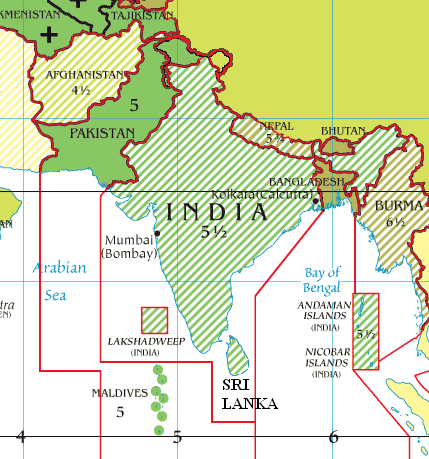|
Danabari
Danabari is a town and Village Development Committee in Ilam District in the Province No. 1 of eastern Nepal. At the time of the 2011 Nepal census Nepal conducted a widespread national census in 2011 by the Nepal Central Bureau of Statistics. Working in cooperation with the 58 municipalities and the 3,915 Village Development Committees at a district level, they recorded data from all the m ... it had a population of 14302 persons living in 1492 individual households. Education College, +2 Level and Schools * Garuwa Multiple Campus * Kankai Higher Secondary School (est. 2017 B.S.) * Yuwa Barsha Secondary School * New Light Secondary School * SM Academy * Shree Nepal Academy * Laxmi Adarsha Secondary School * Deep Jyoti Primary School, Katteltar * Garuwa Primary School, Sukrabare etc. References External linksUN map of the municipalities of Ilam District Populated places in Ilam District {{IlamNP-geo-stub ... [...More Info...] [...Related Items...] OR: [Wikipedia] [Google] [Baidu] |
Ilam District
Ilam district () is one of Districts of Province No. 1, 14 districts of Koshi Province of eastern Nepal. It is a Geography of Nepal#The Hill Region, Hill districts of Nepal, district and covers . The 2011 Nepal census, 2011 census counted 290,254 inhabitants. The municipality of Ilam, Nepal, Ilam is the district headquarters and is about from Kathmandu. Ilam attracts many researchers and scientists for the study of medicinal and aromatic plants, orchids, rare birds and the red panda. Ilam stretches from the Terai belt to the upper hilly belt of this Himalayan nation. Etymology The name ''Ilam'' is derived from the Limbu language in which "IL" means twisted and "Lam" means road. Ilam was one of the ten self ruling states of Limbuwan before the reunification of Nepal. Its ruler, King Hangshu Phuba Lingdom of Lingdom dynasty, ruled Ilam as a confederate state of Limbuwan until 1813 AD. The treaty between the other Limbuwan states and the King of Gorkha (Gorkha-Limbuwan Treaty o ... [...More Info...] [...Related Items...] OR: [Wikipedia] [Google] [Baidu] |
Nepalese Federal States
The Provinces of Nepal, officially the Autonomous Nepalese Provinces (), were formed on 20 September 2015 in accordance with Schedule 4 of the Constitution of Nepal. The seven provinces were formed by grouping the existing districts. The current system of seven provinces replaced an earlier system where Nepal was divided into 14 administrative zones which were grouped into five development regions. History A committee was formed to restructure administrative divisions of Nepal on 23 December 1956 and in two weeks, a report was submitted to the government. In accordance with The ''Report On Reconstruction Of Districts Of Nepal, 2013'' (), the country was first divided into seven ''Kshetras'' (areas). #Arun Kshetra #Janakpur Kshetra #Kathmandu Kshetra #Gandaki Kshetra #Kapilavastu Kshetra #Karnali Kshetra #Mahakali Kshetra In 1962, all ''Kshetras'' were dissolved and the country was restructured into 75 development districts; those districts were further grouped into 14 zones ... [...More Info...] [...Related Items...] OR: [Wikipedia] [Google] [Baidu] |
Province No 1
Koshi Province () is an autonomous province of Nepal adopted by the Constitution of Nepal on 20 September 2015. It covers an area of , about 17.5% of the country's total area. With the industrial city of Biratnagar as its capital, the province includes the towns of Birtamod, Sundar Haraincha, Damak, Dharan, Itahari, Triyuga Municipality and Mechinagar, and Mount Everest, Kangchenjunga and Ama Dablam. Koshi River, the largest river of the nation, forms the province's western boundary. Under the First-past-the-post voting system issued by the Constituency Delimitation Commission, Nepal, the province hosts 28 parliamentary seats and 56 provincial assembly seats. The province is bordered by the Tibet Autonomous Region of China to the north, the Indian states of Sikkim and West Bengal to the east, Bihar to the south, and Bagmati Province and Madhesh Province to the west. According to the 2021 Nepal census, there are around five million people in the province, with a population densi ... [...More Info...] [...Related Items...] OR: [Wikipedia] [Google] [Baidu] |
Districts Of Nepal
Districts in Nepal are second level of administrative divisions after provinces. Districts are subdivided into municipalities and rural municipalities. There are seven provinces and 77 districts in Nepal. After the 2015 reform of administrative divisions, Nawalparasi District and Rukum District were respectively divided into Parasi District and Nawalpur District, and Eastern Rukum District and Western Rukum District. District officials District official include: * Chief District Officer, an official under Ministry of Home Affairs is appointed by the government as the highest administrative officer in a district. The C.D.O is responsible for proper inspection of all the departments in a district such as health, education, security and all other government offices. * District Coordination Committee acts as an executive to the District Assembly. The DCC coordinates with the Provincial Assembly to establish coordination between the Provincial Assembly and rural muni ... [...More Info...] [...Related Items...] OR: [Wikipedia] [Google] [Baidu] |
Nepal Time
Nepal Standard Time (NPT) is the time zone for Nepal. With a time offset from Coordinated Universal Time (UTC) of UTC+05:45 all over Nepal, it is one of only three time zones with a 45-minute offset from UTC.The others are Chatham Island Standard Time, with an offset of UTC+12:45, and the unofficial Australian Central Western Time, with an offset of UTC+08:45. Calculation NPT is an approximation of Kathmandu mean time, which is 5 hours, 41 minutes, and 16 seconds ahead of UTC. The standard meridian passes through the peak of Gaurishankar mountain about east of Kathmandu. History Nepal used local solar time until the year 1920, in Kathmandu UTC+05:41:16. In 1920, Nepal adopted Indian Standard Time Indian Standard Time (IST), sometimes also called India Standard Time, is the time zone observed throughout the Republic of India, with a time offset of UTC+05:30. India does not observe daylight saving time or other seasonal adjustments. I ..., UTC+05:30. In 1986 ... [...More Info...] [...Related Items...] OR: [Wikipedia] [Google] [Baidu] |
Town
A town is a type of a human settlement, generally larger than a village but smaller than a city. The criteria for distinguishing a town vary globally, often depending on factors such as population size, economic character, administrative status, or historical significance. In some regions, towns are formally defined by legal charters or government designations, while in others, the term is used informally. Towns typically feature centralized services, infrastructure, and governance, such as municipal authorities, and serve as hubs for commerce, education, and cultural activities within their regions. The concept of a town varies culturally and legally. For example, in the United Kingdom, a town may historically derive its status from a market town designation or City status in the United Kingdom, royal charter, while in the United States, the term is often loosely applied to incorporated municipality, municipalities. In some countries, such as Australia and Canada, distinction ... [...More Info...] [...Related Items...] OR: [Wikipedia] [Google] [Baidu] |
Village Development Committee (Nepal)
A village development committee (; ''gāum̐ vikās samiti'') in Nepal was the lower administrative part of its Ministry of Federal Affairs and Local Development. Each district had several VDCs, similar to municipalities but with greater public-government interaction and administration. There were 3,157 village development committees in Nepal. Each village development committee was further divided into several wards () depending on the population of the district, the average being nine wards. Purpose The purpose of village development committees is to organise the village people structurally at a local level and creating a partnership between the community and the public sector for improved service delivery system. A village development committee has the status of an autonomous institution and the authority to interact with the more centralised institutions of governance in Nepal. In doing so, the village development committee gives the village people an element of contr ... [...More Info...] [...Related Items...] OR: [Wikipedia] [Google] [Baidu] |
Province No
A province is an administrative division within a country or state. The term derives from the ancient Roman , which was the major territorial and administrative unit of the Roman Empire's territorial possessions outside Italy. The term ''province'' has since been adopted by many countries. In some countries with no actual provinces, "the provinces" is a metaphorical term meaning "outside the capital city". While some provinces were produced artificially by colonial powers, others were formed around local groups with their own ethnic identities. Many have their own powers independent of central or federal authority, especially in Canada and Pakistan. In other countries, like China or France, provinces are the creation of central government, with very little autonomy. Etymology The English word ''province'' is attested since about 1330 and derives from the 13th-century Old French , which itself comes from the Latin">-4; we might wonder whether there's a point at which it's ap ... [...More Info...] [...Related Items...] OR: [Wikipedia] [Google] [Baidu] |
Nepal
Nepal, officially the Federal Democratic Republic of Nepal, is a landlocked country in South Asia. It is mainly situated in the Himalayas, but also includes parts of the Indo-Gangetic Plain. It borders the Tibet Autonomous Region of China China–Nepal border, to the north, and India India–Nepal border, to the south, east, and west, while it is narrowly separated from Bangladesh by the Siliguri Corridor, and from Bhutan by the States and union territories of India, Indian state of Sikkim. Nepal has a Geography of Nepal, diverse geography, including Terai, fertile plains, subalpine forested hills, and eight of the world's ten List of highest mountains#List, tallest mountains, including Mount Everest, the highest point on Earth. Kathmandu is the nation's capital and List of cities in Nepal, its largest city. Nepal is a multi-ethnic, multi-lingual, multi-religious, and multi-cultural state, with Nepali language, Nepali as the official language. The name "Nepal" is first record ... [...More Info...] [...Related Items...] OR: [Wikipedia] [Google] [Baidu] |
2011 Nepal Census
Nepal conducted a widespread national census in 2011 by the Nepal Central Bureau of Statistics. Working in cooperation with the 58 municipalities and the 3,915 Village Development Committees at a district level, they recorded data from all the municipalities and villages of each district. The data included statistics on population size, households, sex and age distribution, place of birth, residence characteristics, literacy, marital status, religion, language spoken, caste/ethnic group, economically active population, education, number of children, employment status, and occupation. *Total population in 2011: 26,494,504 *Increase since last census in 2001: 3,343,081 *Annual population growth rate (exponential growth): 1.35 * ... [...More Info...] [...Related Items...] OR: [Wikipedia] [Google] [Baidu] |
Digital Himalaya
The Digital Himalaya project was established in December 2000 by Mark Turin, Alan Macfarlane, Sara Shneiderman, and Sarah Harrison. The project's principal goal is to collect and preserve historical multimedia materials relating to the Himalaya, such as photographs, recordings, and journals, and make those resources available over the internet and offline, on external storage media. The project team has digitized older ethnographic collections and data sets that were deteriorating in their analogue formats, to protect them from deterioration and make them available and accessible to originating communities in the Himalayan region and a global community of scholars. The project was founded at the Department of Anthropology of the University of Cambridge, moved to Cornell University in 2002 (when a collaboration with the University of Virginia was initiated), and then back to the University of Cambridge in 2005. From 2011 to 2014, the project was jointly hosted between the Unive ... [...More Info...] [...Related Items...] OR: [Wikipedia] [Google] [Baidu] |




